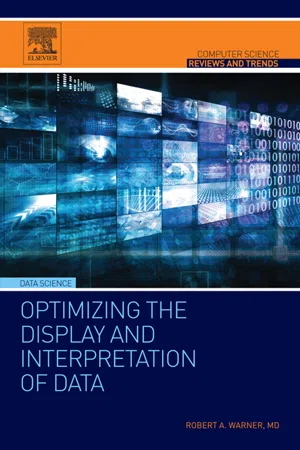
- 148 pages
- English
- ePUB (mobile friendly)
- Available on iOS & Android
Optimizing the Display and Interpretation of Data
About This Book
"What information do these data reveal?" "Is the information correct?" "How can I make the best use of the information?" The widespread use of computers and our reliance on the data generated by them have made these questions increasingly common and important. Computerized data may be in either digital or analog form and may be relevant to a wide range of applications that include medical monitoring and diagnosis, scientific research, engineering, quality control, seismology, meteorology, political and economic analysis and business and personal financial applications. The sources of the data may be databases that have been developed for specific purposes or may be of more general interest and include those that are accessible on the Internet.
In addition, the data may represent either single or multiple parameters. Examining data in its initial form is often very laborious and also makes it possible to "miss the forest for the trees" by failing to notice patterns in the data that are not readily apparent. To address these problems, this monograph describes several accurate and efficient methods for displaying, reviewing and analyzing digital and analog data. The methods may be used either singly or in various combinations to maximize the value of the data to those for whom it is relevant. None of the methods requires special devices and each can be used on common platforms such as personal computers, tablets and smart phones. Also, each of the methods can be easily employed utilizing widely available off-the-shelf software.
Using the methods does not require special expertise in computer science or technology, graphical design or statistical analysis. The usefulness and accuracy of all the described methods of data display, review and interpretation have been confirmed in multiple carefully performed studies using independent, objective endpoints. These studies and their results are described in the monograph. Because of their ease of use, accuracy and efficiency, the methods for displaying, reviewing and analyzing data described in this monograph can be highly useful to all who must work with computerized information and make decisions based upon it.
- The reader will learn methods for easily increasing the speed and accuracy of reviewing data that are relevant to many diverse fields of endeavor
- This will reduce the drudgery associated with reviewing the data and simultaneously improve the reliability of the interpretations that result from the review
- This increased efficiency of review will make it easier to provide "full disclosure" of the data to all those responsible for making decisions based on any actionable information that might be contained in the data
Frequently asked questions
Information
The Scope and Importance of Computerized Data
Abstract
Keywords
Table of contents
- Cover
- Title page
- Table of Contents
- Copyright
- Dedication
- Preface
- Author Biography
- Chapter 1: The Scope and Importance of Computerized Data
- Chapter 2: Using Z Scores for the Display and Analysis of Data
- Chapter 3: Moving Averages for Identifying Trends and Changes in the Data
- Chapter 4: Using Composite Analog Displays to Summarize and Interpret Data
- Chapter 5: The Stacked Frame Display for the Rapid Review and Analysis of Data
- Chapter 6: Effective Methods for Analyzing Digital Data
- Chapter 7: The Importance of Conditional Probability